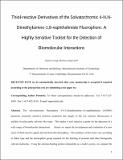| dc.contributor.author | Loving, Galen S. | |
| dc.contributor.author | Imperiali, Barbara | |
| dc.date.accessioned | 2012-03-08T19:49:23Z | |
| dc.date.available | 2012-03-08T19:49:23Z | |
| dc.date.issued | 2009-10 | |
| dc.identifier.issn | 1043-1802 | |
| dc.identifier.issn | 1520-4812 | |
| dc.identifier.uri | http://hdl.handle.net/1721.1/69607 | |
| dc.description.abstract | The solvatochromic fluorophore 4-N,N-dimethylamino-1,8-naphthalimide (4-DMN) possesses extremely sensitive emission properties due largely to the low intrinsic fluorescence it exhibits in polar protic solvents such as water. This makes it well suited as a probe for the detection of a wide range of biomolecular interactions. Herein we report the development and evaluation of a new series of thiol-reactive agents derived from this fluorophore. The members of this series vary according to linker type and the electrophilic group required for the labeling of proteins and other biologically relevant molecules. Using the calcium-binding protein calmodulin as a model system, we compare the performance of the 4-DMN derivatives to that of several commercially available solvatochromic fluorophores identifying many key factors important to the successful application of such tools. This study also demonstrates the power of this new series of labeling agents by yielding a fluorescent calmodulin construct capable of producing a greater than 100-fold increase in emission intensity upon binding to calcium. | en_US |
| dc.description.sponsorship | National Institutes of Health (U.S.) (NIH Cell Migration Consortium (GM064346)) | en_US |
| dc.description.sponsorship | National Science Foundation (U.S.) (NSF CHE-0414243) | en_US |
| dc.description.sponsorship | National Institutes of Health (U.S.) (Interdepartmental Biotechnology Training Grant T32 GM08334) | en_US |
| dc.description.sponsorship | Massachusetts Institute of Technology (Department of Chemistry Instrumentation Facility (NSF CHE-9808061)) | en_US |
| dc.description.sponsorship | Massachusetts Institute of Technology (Department of Chemistry Instrumentation Facility (NSF DBI-9729592)) | en_US |
| dc.description.sponsorship | Massachusetts Institute of Technology (Department of Chemistry Instrumentation Facility (NSF CHE-0234877)) | en_US |
| dc.description.sponsorship | Massachusetts Institute of Technology (Biophysical Instrumentation Facility for the Study of Complex Macromolecular Systems (NSF-0070319)) | en_US |
| dc.language.iso | en_US | |
| dc.publisher | American Chemical Society | en_US |
| dc.relation.isversionof | http://dx.doi.org/10.1021/bc900319z | en_US |
| dc.rights | Article is made available in accordance with the publisher's policy and may be subject to US copyright law. Please refer to the publisher's site for terms of use. | en_US |
| dc.source | Prof. Imperiali via Erja Kajosalo | en_US |
| dc.title | Thiol-reactive Derivatives of the Solvatochromic 4-N,N-Dimethylamino-1,8-naphthalimide Fluorophore: A Highly Sensitive Toolset for the Detection of Biomolecular Interactions | en_US |
| dc.type | Article | en_US |
| dc.identifier.citation | Loving, Galen, and Barbara Imperiali. “Thiol-Reactive Derivatives of the Solvatochromic 4-N,N-Dimethylamino-1,8-naphthalimide Fluorophore: A Highly Sensitive Toolset for the Detection of Biomolecular Interactions.” Bioconjugate Chemistry 20.11 (2009): 2133–2141. | en_US |
| dc.contributor.department | Massachusetts Institute of Technology. Department of Chemistry | en_US |
| dc.contributor.approver | Imperiali, Barbara | |
| dc.contributor.mitauthor | Imperiali, Barbara | |
| dc.contributor.mitauthor | Loving, Galen S. | |
| dc.relation.journal | Bioconjugate Chemistry | en_US |
| dc.eprint.version | Author's final manuscript | en_US |
| dc.type.uri | http://purl.org/eprint/type/JournalArticle | en_US |
| eprint.status | http://purl.org/eprint/status/PeerReviewed | en_US |
| dspace.orderedauthors | Loving, Galen; Imperiali, Barbara | en |
| dc.identifier.orcid | https://orcid.org/0000-0002-5749-7869 | |
| mit.license | PUBLISHER_POLICY | en_US |
| mit.metadata.status | Complete | |
